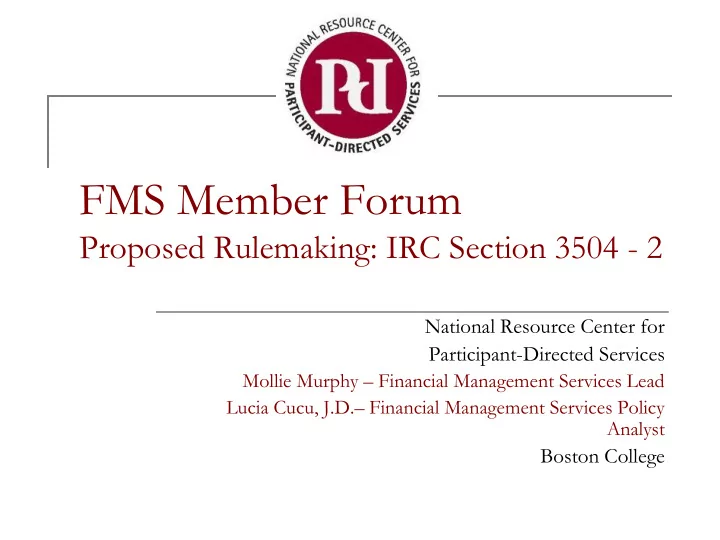

FMS Member Forum Proposed Rulemaking: IRC Section 3504 - 2 National Resource Center for Participant-Directed Services Mollie Murphy – Financial Management Services Lead Lucia Cucu, J.D. – Financial Management Services Policy Analyst Boston College
The Original Section 3504 Proposes adding part two to Internal Revenue Code Section 3504 Section 3504 is the Section that makes Agents jointly liable with employers who designate them as Agents (IRS Form 2678) Section 3504 is integral to why the IRS feels “ safe ” with states using the Fiscal/Employer Agent model The IRS strongly dislikes the Agency with Choice model
To Whom Would This Section Apply? Applies to an entity that: Pays wages on behalf of an employer AND Has not been authorized to act as an agent with a Form 2678 AND Is not a common law employer of the workers it pays AND Told an employer (incorrectly) that it is an employer or “ co-employer ” AND As such, will pay workers and manage the taxes
IRS Goals IRS wants to make sure it can: Hold liable a payor who enters into an agreement with an employer AND Tell the employer it will be an employer or co-employer AND Will pay all employer taxes BUT Does not file a Form 2678 or meet tests to be the common law employer
The Proposed Rules Such a payor as previously described would be an agent under the proposed rules Would be jointly liable with the employer under 3504-2 for any employment taxes and penalties
Fiscal/Employer Agents Excluded Does not apply to agents authorized under the current Section 3504 (Because they are already included)
Qualifying for Section 3504-2 Person/entity that enters into a "service agreement" to pay wages or compensation on behalf of an employer is considered to be designated as an agent of that employer. Has the obligation to "perform the acts required of an employer under each applicable chapter of the Code and the relevant regulations with respect to the wages or compensation paid by such payor."
The Service Agreement The "service agreement" must state the following in order to trigger liability under this section: Payor asserts or implies it is the employer or co-employer Payor agrees to pay wages or compensation to the workers Payor agrees to pay taxes with respect to those wages The “ service agreement ” can be oral or written
Assertion as Employer Can be Implicit Payer can assert it is the employer explicitly OR Implicitly by performing functions such as: Recruiting or hiring employees Assigning workers as temporary or permanent members of the client ’ s work force Hiring the workers as its own and then providing them back to perform services for the client Filing employment taxes or returns for the wages paid to workers under its own EIN
Exceptions to Implicit Employer Status A payer is NOT considered an agent under the proposed rules if: Taxes filed under client ’ s own EIN (as with a payroll provider) The payor is determined to be the common law employer of workers because the payor would be liable as the employer and Section 3504 wouldn ’ t come into play
Why Does This Matter to Participant Direction? Agency with Choice Protection for participants Legitimizes co-employment with IRS? Traditional Providers Who Offer Ample Participant Control Protection for participants
Comments? Comments due to IRS April 29, 2013 NRCPDS sending comments on behalf of members Full proposed rules available here: http://www.gpo.gov/fdsys/pkg/FR-2013-01- 29/html/2013-01857.htm
Recommend
More recommend